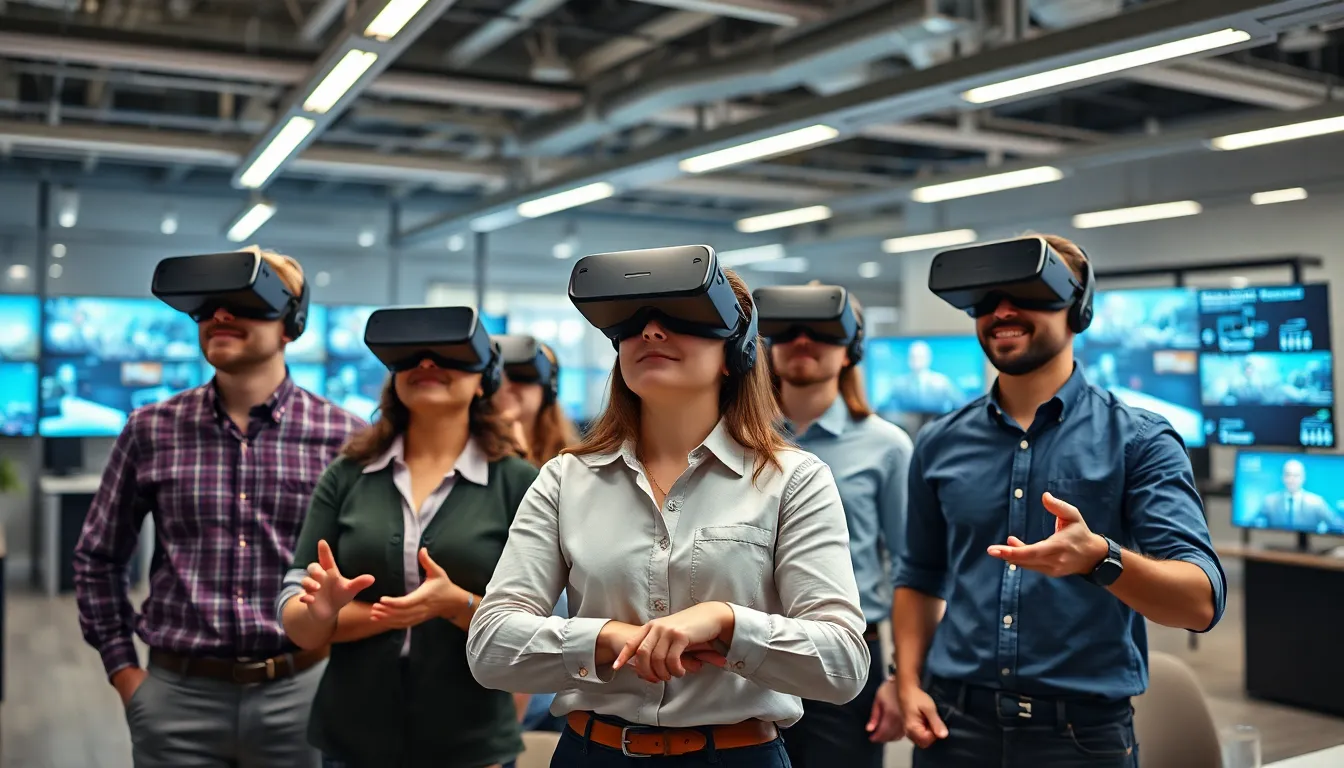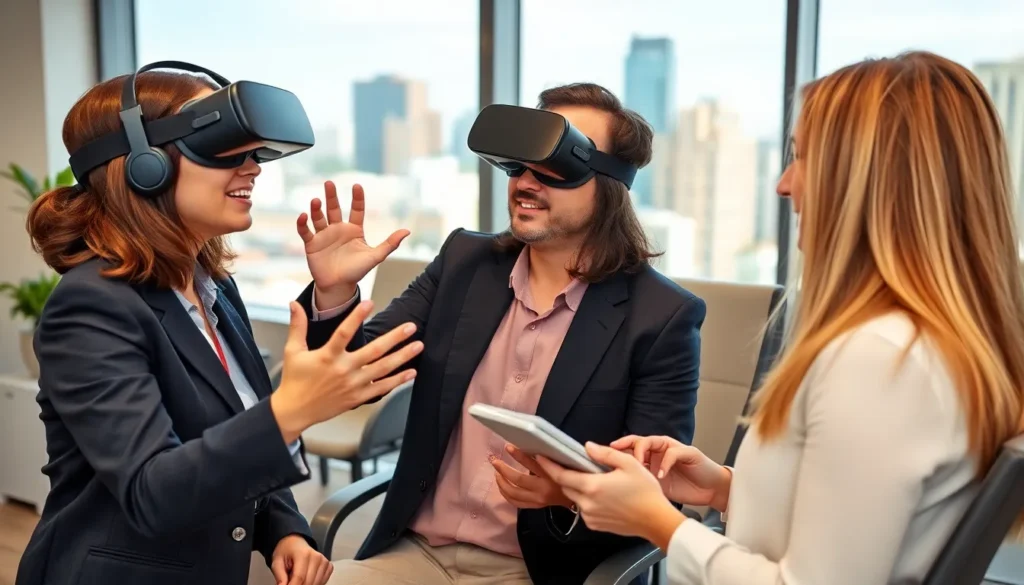Imagine stepping into a world where meetings feel like epic adventures and training sessions don’t involve snoozing through PowerPoint slides. Virtual Reality (VR) is shaking up the business landscape, making it not just a tool but a game-changer. Companies are discovering that VR can transform everything from employee training to customer engagement, all while keeping things fresh and fun.
As businesses dive into this immersive technology, they’re finding that VR isn’t just for gamers anymore. It’s a powerful way to enhance collaboration, boost creativity, and even reduce costs. So why not trade in those stale conference rooms for a virtual space that inspires innovation? Embracing VR could be the ticket to staying ahead in a competitive market, and who wouldn’t want to be the trendsetter in their industry?
Table of Contents
ToggleUnderstanding Virtual Reality
Virtual Reality (VR) represents a groundbreaking technology impacting industries. It creates immersive environments that simulate physical presence in a digital world.
Definition of Virtual Reality
Virtual Reality immerses users in a computer-generated environment where they can interact in real-time. By employing head-mounted displays and motion tracking, it offers an experience that feels real. Users engage with virtual objects and surroundings, leading to enhanced participation. This technology finds applications across various sectors such as education, healthcare, and real estate. Organizations leverage VR to create realistic training scenarios that improve learning outcomes and retention.
Types of Virtual Reality Technologies
Several types of VR technologies cater to different business needs. Fully immersive VR involves advanced headsets and motion tracking, providing a complete sensory experience. Non-immersive VR allows users to explore 3D environments on standard screens without headsets. Collaborative VR tools enable multiple users to interact in shared virtual spaces, enhancing teamwork. Mobile VR uses smartphones within headsets to create accessible experiences on-the-go. Augmented reality, while distinct, integrates digital elements into the physical world, expanding the possibilities for interactive experiences in business contexts.
Benefits of Implementing VR in Business

Utilizing virtual reality offers numerous advantages for businesses. The technology enhances employee experiences and customer interactions, providing new opportunities for growth.
Enhanced Training Experiences
VR transforms corporate training by creating immersive scenarios that replicate real-world tasks. Employees navigate complex situations in a safe space, leading to improved skill retention. Studies show that VR training can increase learning retention rates by up to 75%. It fosters active participation, allowing trainees to learn through hands-on experiences rather than passive observation. Companies across industries, including healthcare and manufacturing, implement VR to simulate critical scenarios, enhancing preparation for real-life challenges. Moreover, personalized training paths cater to individual learning styles, making education not only effective but also engaging.
Improved Customer Engagement
Engaging customers becomes easier with immersive VR experiences. Businesses create virtual showrooms or interactive product demonstrations, allowing potential buyers to visualize offerings before making purchases. Statistics indicate that VR content can increase engagement rates by 70%, making it a powerful marketing tool. Users interact dynamically with products, facilitating a deeper emotional connection with brands. Leading companies also utilize VR for personalized experiences, tailoring environments based on user preferences. This enhanced engagement not only boosts customer satisfaction but also encourages loyalty, which is crucial in a competitive marketplace.
Challenges of Implementing VR in Business
Implementing VR in business presents various challenges that organizations must navigate. These obstacles include cost considerations and technical limitations that can impact the successful adoption of virtual technologies.
Cost Considerations
Cost poses a significant barrier to VR adoption. Initial investment for VR hardware, software, and installation often reaches substantial amounts, sometimes exceeding multiple thousands of dollars. Ongoing maintenance costs further add to the financial burden, necessitating budget allocations for upgrades and repairs. Training employees to effectively use VR systems incurs additional expenses, which may deter some companies from moving forward. ROI calculations may appear uncertain, particularly in industries lacking proven VR applications. Consequently, businesses must weigh these costs against potential benefits to make informed decisions.
Technical Limitations
Technical limitations also challenge VR implementation. Hardware compatibility issues may arise, as not all devices support the latest VR technologies, resulting in inconsistent user experiences. Performance requirements for VR applications can strain existing IT infrastructure, requiring significant upgrades to support real-time interactions. Software compatibility presents another hurdle, with few standardized platforms available for businesses seeking tailored solutions. Training personnel to navigate these complexities demands time and resources. Addressing these technical aspects is crucial for successful VR integration in business environments.
Case Studies of VR Implementation
Numerous organizations have successfully integrated VR into their operations, showcasing the technology’s potential to enhance various business functions.
Successful Business Applications
Retail companies utilize VR to create virtual store experiences, enabling customers to browse products from their homes. Ford’s immersive training program uses VR to instruct assembly line workers, resulting in a 60% decrease in training time. Healthcare providers have adopted VR for surgical training simulations, significantly enhancing medical skills and confidence. Other industries leverage VR for remote collaboration, allowing geographically dispersed teams to engage effectively in virtual meetings and brainstorming sessions. These innovative applications demonstrate how VR not only enhances customer experiences but also optimizes employee training and collaboration.
Lessons Learned from Failures
Many businesses encounter challenges during VR implementation that serve as valuable lessons. Some companies struggle with high initial hardware costs, leading to budget constraints that hinder effective integration. Others face technical difficulties, including software compatibility and performance issues, which create frustration and reduce productivity. Limited employee acceptance of VR technology can occur, particularly when proper training is absent. Furthermore, organizations that fail to align VR strategies with business goals often waste resources and miss opportunities. These insights highlight the importance of thorough planning and support for fostering successful VR adoption.
Future Trends in VR for Business
Virtual reality continues to evolve, shaping the future of business applications. Companies must prepare for significant advancements that enhance how they operate.
Innovations on the Horizon
Emerging technologies promise to expand VR capabilities in business. Enhanced graphics and artificial intelligence integration will create even more immersive experiences. Developers focus on making VR systems more user-friendly, which could reduce the training time needed. Cloud-based VR solutions offer scalability and lower costs. Additionally, advances in haptic feedback technology will facilitate realistic interactions, making virtual experiences more tangible. Adoption of 5G networks will further enhance performance, allowing seamless connectivity in VR applications.
Predictions for Industry Growth
Market analysts project rapid growth for the VR business sector, estimating it will reach $57.55 billion by 2027. This growth derives from an increased focus on remote collaboration and virtual training. Industries such as retail are expected to invest heavily in VR, creating more engaging shopping experiences. Education sectors prioritize immersive learning environments to boost engagement and retention. Healthcare providers increasingly utilize VR for training and therapy, aiming to enhance patient outcomes. As businesses recognize the benefits, a diverse range of sectors will embrace VR technology, reshaping operational strategies and customer interactions.
Embracing Virtual Reality in business offers a pathway to innovation and enhanced efficiency. As organizations navigate the challenges of implementation, the rewards can significantly outweigh the initial investments. VR not only transforms training and collaboration but also elevates customer engagement in ways traditional methods cannot match.
With advancements on the horizon and a growing market, companies that adopt VR technology position themselves as leaders in their industries. By staying ahead of the curve and integrating immersive experiences into their operations, businesses can foster creativity while driving growth and customer loyalty. The future of business is virtual, and those who adapt will thrive.




